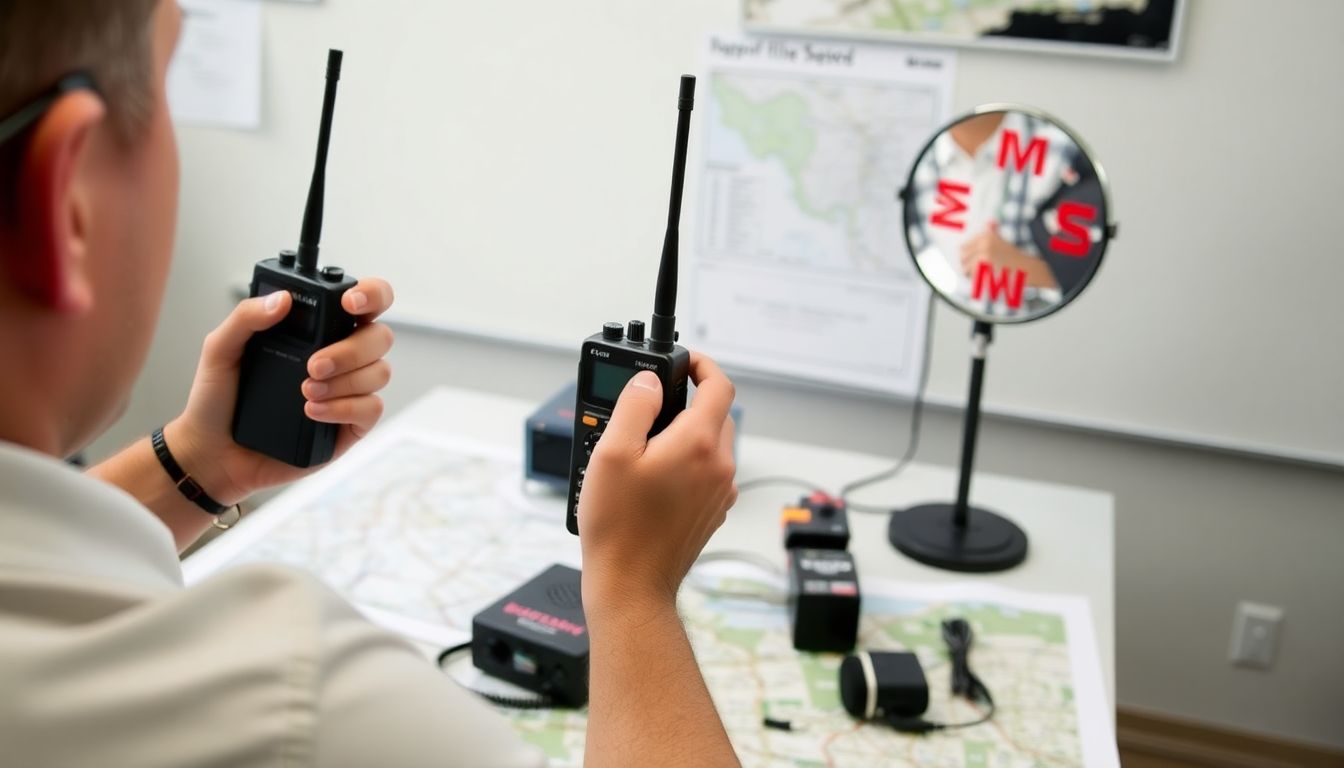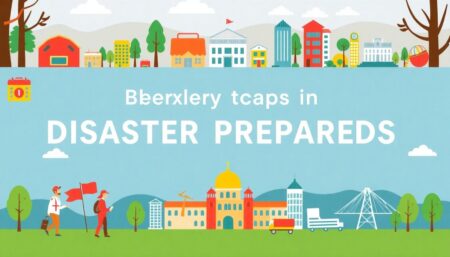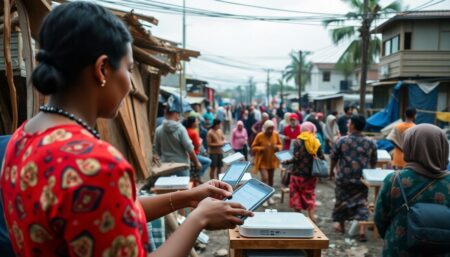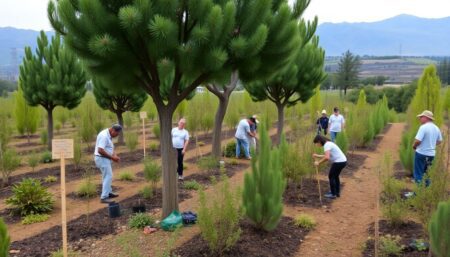In today’s interconnected world, we often take reliable communication for granted. However, what happens when the grid goes down, and our usual communication methods fail? This is not a hypothetical scenario; it’s a reality that many have faced during natural disasters, power outages, or other crisis situations. According to the Federal Emergency Management Agency (FEMA), up to 75% of all emergency calls are made using wireless networks, which can quickly become overwhelmed or inoperable during large-scale disasters. This raises a crucial question: How can we ensure effective communication when our usual methods are unavailable? The purpose of this article is to equip you with the knowledge and tools necessary to maintain communication in off-grid situations. We will delve into the world of emergency radios, signal mirrors, and offline messaging systems, exploring their capabilities, limitations, and how to use them effectively. By the end of this article, you will have a comprehensive understanding of off-grid communication methods, enabling you to stay connected and informed during crisis situations. Agreeably, the thought of being cut off from the world can be unsettling. But consider this: during Hurricane Katrina, many people were left without power and communication for weeks. In such situations, having alternative communication methods can mean the difference between waiting for help and receiving it promptly. This article promises to provide you with practical, real-world solutions that could potentially save lives. Before we dive into the specifics, let’s briefly preview what we will cover. We will start by discussing the importance of emergency radios, exploring their features, and how to choose the right one for your needs. Next, we will delve into the world of signal mirrors and other visual signaling methods, learning how to use them effectively to attract attention and communicate over long distances. Finally, we will explore offline messaging systems, looking at how they work and how to set them up for use in crisis situations. So, whether you’re a prepper, an outdoor enthusiast, or simply someone who wants to be prepared for unexpected situations, this article is for you. Let’s embark on this journey to learn about off-grid communication methods and ensure that you’re never truly cut off from the world.
Mastering Off-Grid Communication: Essential Methods for Crisis Situations
In today’s interconnected world, communication is often taken for granted, with instant messaging and calls possible at the touch of a button. However, in crisis situations, such as natural disasters, power outages, or grid failures, these modern conveniences can become unreliable or unavailable. This is where off-grid communication methods become essential. Mastering these techniques can mean the difference between isolation and connection, between waiting for help and being able to summon it, between uncertainty and reassurance. Off-grid communication encompasses a wide range of methods, from low-tech solutions like signal mirrors and whistles to more advanced tools such as satellite phones and ham radios. Each has its own advantages and limitations, and understanding how and when to use them is crucial. For instance, a signal mirror can reflect sunlight over long distances, useful for attracting attention when visual contact is possible, while a satellite phone can provide voice and data communication regardless of one’s location, but at a significant cost. Learning to use these tools effectively requires practice and understanding of their capabilities. It’s also important to understand the legal and ethical considerations surrounding their use, such as the appropriate times to use emergency frequencies and the importance of not causing interference with critical communications. Moreover, off-grid communication isn’t just about having the right tools; it’s also about knowing how to use them in conjunction with other survival skills. For example, understanding basic navigation can help you move towards a known communication point, while knowledge of first aid can help you stabilize a situation until help arrives. In essence, mastering off-grid communication is about being prepared for the unexpected, about having the skills and tools to adapt to changing circumstances, and about being able to communicate effectively when other means fail. It’s about turning potential isolation into connection, uncertainty into reassurance, and waiting into action.

Understanding the Importance of Off-Grid Communication
In the face of natural disasters, political instability, or technological failures, traditional communication networks can crumble, leaving us vulnerable and isolated. This is where off-grid communication systems step in, playing a critical role in crisis situations. Off-grid communication refers to independent, self-sufficient communication networks that do not rely on traditional infrastructure. They can be as simple as a two-way radio or as complex as a mesh network of satellite phones and repeaters. The importance of these systems cannot be overstated. When disaster strikes, it’s not uncommon for cell towers to be damaged or overwhelmed, and internet services to be disrupted. This loss of infrastructure and services can be catastrophic, as it hinders our ability to call for help, receive updates, or coordinate relief efforts. Off-grid communication systems provide a lifeline in these situations, allowing us to maintain contact with the outside world even when traditional networks fail. They enable us to call for help, receive vital information, and coordinate with others, all of which are crucial for ensuring our safety and survival. Moreover, off-grid communication systems foster a sense of self-sufficiency and independence. They remind us that we don’t always have to rely on external systems and services, but can instead take matters into our own hands. By investing in off-grid communication, we’re not only preparing for the worst but also empowering ourselves to be more resilient and self-reliant. In essence, understanding and embracing the importance of off-grid communication is not just about being prepared for crisis situations, but also about taking control of our communication needs and ensuring that we’re never truly cut off from the world around us.

Emergency Radios: A Reliable Off-Grid Communication Tool
In the face of natural disasters or power outages, reliable communication can be a lifesaver. This is where emergency radios step in, providing a robust off-grid communication tool that can keep you informed and connected when other means of communication fail. These radios are designed to receive crucial information from emergency services, weather updates, and local news, ensuring you stay updated and prepared.Emergency radios come in various types, each with its own set of advantages and disadvantages. Hand-crank radios, for instance, are a popular choice due to their portability and sustainability. They generate power through a dynamo that converts the mechanical energy from the crank into electrical energy, making them ideal for situations where power sources are scarce. However, they may not provide the same level of power as other types, which could affect the radio’s range and audio quality. Solar-powered radios, on the other hand, harness the power of the sun to charge their batteries. They are eco-friendly and can provide a steady power supply, provided there’s sufficient sunlight. But they may struggle in low-light conditions or at night. Battery-powered radios offer immediate power and can provide high-quality audio, but they rely on disposable or rechargeable batteries that may run out during an emergency.Despite their differences, all emergency radios share a common goal: to provide access to critical information and the ability to send distress signals. Many models come with features like NOAA weather alerts, LED flashlights, and SOS signals, making them versatile tools for emergency situations. When choosing an emergency radio, consider factors such as power source, durability, and additional features that cater to your specific needs.Some of the best emergency radios on the market include the Eton FRX5, which offers a hand crank, solar panel, and USB charging options, along with a built-in LED flashlight and NOAA weather alerts. The Midland ER310 is another reliable choice, offering a 26-channel weather scan and alert system, along with a USB charging port and a built-in LED flashlight. Ultimately, the best emergency radio is one that suits your needs, is easy to use, and can provide reliable communication when you need it most.

Signal Mirrors: A Simple yet Effective Visual Communication Method
Signal mirrors, also known as heliographs or sun mirrors, are a simple yet effective visual communication method that has been used for centuries. They work by reflecting sunlight onto a distant target, creating a bright, visible signal that can be seen over long distances. The principle behind a signal mirror is straightforward: when light hits the mirror’s surface, it is reflected in a single direction, creating a concentrated beam of light that can be seen from far away. This reflected light can be used to send Morse code messages, attract attention, or signal for help in off-grid situations.Signal mirrors offer several advantages in off-grid communication. Firstly, they are lightweight and compact, making them easy to carry in a backpack or emergency kit. Secondly, they require no batteries or external power sources, ensuring that they are always ready to use. Thirdly, they can be seen from great distances, sometimes up to 50 miles away on a clear day, making them ideal for signaling over vast areas. Lastly, they are versatile and can be used in various environments, from deserts to forests, and even at night with the help of a flashlight.To use a signal mirror effectively, follow these steps:1. Hold the mirror in your hand, with the reflective side facing outwards.2. Cup your other hand around the mirror to shield it from ambient light and create a sharper reflection.3. Position the mirror so that the sunlight is reflected onto your target. You may need to adjust your angle slightly to get the reflection right.4. Once you have a steady reflection, move the mirror in a slow, steady arc to send your message. For Morse code, use short, quick movements for dots, and longer, slower movements for dashes.5. To attract attention, try to reflect the sunlight onto a distant object, such as a building or a mountain, rather than directly onto another person. This can create a more visible signal.If you find yourself without a signal mirror in an off-grid situation, you can make a DIY one using a small piece of aluminum foil and a piece of glass or plastic. Simply wrap the foil around the glass or plastic to create a reflective surface, and use it in the same way as a regular signal mirror. While not as effective as a purpose-made mirror, a DIY signal mirror can still be a valuable tool in an emergency situation.

Offline Messaging Apps: Staying Connected Without a Signal
In today’s interconnected world, communication is often taken for granted, with real-time messaging apps like WhatsApp and Messenger being the norm. However, in crisis situations such as natural disasters, power outages, or remote areas with poor signal, these apps become unreliable. This is where offline messaging apps step in, offering a lifeline when connectivity is scarce. These apps work by utilizing a combination of technologies to send messages and share location data even without a cellular or Wi-Fi signal. Some use a mesh network, where devices within range of each other can communicate directly, creating a decentralized network that doesn’t rely on traditional infrastructure. Others use satellite communication, which can be particularly useful in remote or disaster-struck areas. Features of offline messaging apps include the ability to send text messages, share photos and videos, and even share your location, which can be crucial in emergency situations. To use these apps, simply download and install them, create an account if required, and ensure that your location services are turned on. Some apps may require a subscription or in-app purchases for full functionality, but many offer free basic services. Recommended offline messaging apps include Bridgefy, FireChat, and Serval Mesh, which use mesh networking, as well as GoTenna and Spot, which use long-range radio frequencies and satellite communication respectively. In conclusion, offline messaging apps are a vital tool in crisis situations, providing a means of communication when all else fails. They are easy to use and can make a significant difference in ensuring that people can stay connected and safe.

Setting Up an Amateur Radio Network for Emergency Communication
Amateur radio, often referred to as ‘ham radio,’ is a popular hobby and a vital component of emergency communication systems worldwide. It allows licensed operators to transmit and receive radio frequency signals, enabling communication over long distances, even when other forms of communication, such as cellular networks, fail. In emergency situations, amateur radio networks play a crucial role in providing critical information, coordinating relief efforts, and maintaining contact with isolated communities.Setting up an amateur radio network involves several steps. First, you need to obtain an amateur radio license. In the United States, the Federal Communications Commission (FCC) administers the licensing process. You can apply for a license by passing an exam that tests your knowledge of radio frequency regulations, operating procedures, and safety precautions. The exam is offered by volunteer examiners and is typically held in conjunction with local amateur radio clubs or FCC-licensed facilities.Once licensed, you’ll need to acquire the necessary equipment. This includes a transceiver (a combination of a transmitter and a receiver), an antenna, a power supply, and related accessories. The cost of entry-level equipment can range from a few hundred to a few thousand dollars, depending on the features and capabilities you require. It’s essential to choose equipment that suits your needs and budget, as well as complies with local regulations and FCC guidelines.To set up a network, you’ll need to establish a base station, which is a fixed location where your radio is set up. This could be your home, a community center, or an emergency operations center. You’ll also need to consider the type of antenna you’ll use, as this will affect the range and reliability of your communications. A simple vertical antenna can provide coverage for a local area, while a directional antenna can be used to communicate over longer distances.Once your equipment is set up, it’s crucial to practice using it regularly. Amateur radio networks often hold ‘nets’ or scheduled communication sessions to maintain skills and test equipment. These nets can also serve as a way to build relationships with other operators and learn about emergency communication procedures. Regular practice is essential for maintaining proficiency and ensuring that your network is ready to respond in an emergency.In conclusion, setting up an amateur radio network for emergency communication involves obtaining a license, acquiring the necessary equipment, and practicing regularly. By doing so, you can help ensure that critical information can be shared and that communities can stay connected, even in the most challenging circumstances. Whether you’re a seasoned operator or a newcomer to the hobby, there’s always more to learn and ways to contribute to the vital role that amateur radio plays in emergency communication.

Satellite Phones: A Last Resort for Off-Grid Communication
In the vast, uncharted territories beyond the reach of terrestrial networks, satellite phones emerge as a beacon of connectivity, serving as a last resort for off-grid communication. These rugged, portable devices transmit signals to satellites orbiting the Earth, enabling voice calls, text messages, and data transmission in areas where traditional mobile networks are non-existent. The primary advantage of satellite phones lies in their global coverage, making them an invaluable tool for adventurers, explorers, and professionals working in remote locations. They are also resilient, designed to withstand harsh environmental conditions, ensuring functionality in extreme temperatures, humidity, and shock. However, satellite phones are not without their drawbacks. The most significant is their high cost, with both the devices and airtime plans commanding premium prices. Additionally, their functionality is limited compared to smartphones, lacking features like internet browsing, app usage, and multimedia capabilities. Moreover, satellite phones require a clear line of sight to the sky, making them impractical in dense forests, urban canyons, or indoor settings. Despite these limitations, satellite phones are lifesavers in emergency situations, providing a crucial lifeline to the outside world. When considering a satellite phone, it’s essential to choose a reliable provider with a robust satellite network. Some of the best satellite phones on the market include the Iridium 9555, known for its durability and global coverage; the Inmarsat IsatPhone 2, praised for its long battery life and SOS emergency feature; and the Globalstar GSP-1700, which offers affordable airtime plans. Ultimately, while satellite phones may not be the first choice for everyday communication, they serve a vital role as a last resort in off-grid situations, providing a vital link to the world when all else fails.

Integrating Multiple Off-Grid Communication Methods for Optimal Preparedness
In today’s interconnected world, communication is not only a convenience but a necessity, especially during emergencies or off-grid situations. Integrating multiple off-grid communication methods is crucial for optimal preparedness as it ensures redundancy and increases the likelihood of successful communication when one method fails. A comprehensive communication plan should incorporate various tools and techniques to cover different scenarios and environments.Firstly, consider traditional methods like two-way radios or CB (Citizen Band) radios. These devices operate on different frequencies and can be used to communicate over long distances, even when cellular networks are down. They are particularly useful for reaching out to local communities or emergency services. However, they require line-of-sight and may not work effectively in hilly or mountainous terrain.Satellite phones are another robust off-grid communication tool. They can connect to satellites orbiting the Earth, providing global coverage. This makes them ideal for remote areas where other communication methods may fail. However, they are expensive to purchase and maintain, and their signal can be affected by heavy rain or dense foliage.Handheld amateur (ham) radios are also valuable. They can transmit voice and data over long distances and do not require a license to use in many countries. They can be used to communicate with other ham radio operators, who often have extensive knowledge about emergency preparedness and can provide useful information.Emergency beacons are essential for situations where you need to send a distress signal. They can transmit your location to search and rescue services, even in remote areas. Some models also have two-way communication capabilities.Lastly, consider low-tech methods such as whistles, mirrors, and signal flags. These can be used to communicate visually or audibly over short distances. They may seem primitive, but they can be lifesaving when other methods fail.To create a comprehensive communication plan, start by assessing your needs and the environment you’ll be in. Then, choose a combination of these methods that suits your situation. Ensure you have backup power sources for your devices and that everyone in your group knows how to use each method. Regularly test your plan and update it as needed. By integrating multiple off-grid communication methods, you’re not only preparing for potential emergencies but also ensuring that you’re always connected, no matter what situation arises.

Practicing and Maintaining Off-Grid Communication Skills
In today’s interconnected world, the ability to communicate effectively is not only a convenience but a necessity. However, when off-grid situations arise, such as natural disasters, power outages, or remote adventures, traditional communication methods may become unavailable. Therefore, practicing and maintaining off-grid communication skills is not just a hobby for survivalists; it’s a crucial life skill that everyone should consider. Regular practice and maintenance of these skills ensure that you are prepared to face any communication challenges that may come your way.Staying up-to-date with the latest technology is the first step in maintaining off-grid communication skills. This includes understanding and being able to use various communication devices such as satellite phones, ham radios, and emergency beacons. Regularly reading about advancements in off-grid communication technology can provide valuable insights and help you make informed decisions about the equipment you need.Participating in drills and exercises is another essential aspect of maintaining these skills. These activities allow you to practice using your equipment in real-life scenarios, helping you to identify any potential issues and learn how to troubleshoot them. They also provide an opportunity to test your knowledge and understanding of different communication methods and protocols. Regular drills can help you build confidence and competence, ensuring that you are ready to act when a crisis situation arises.Maintaining your equipment is also crucial. Off-grid communication devices are often exposed to harsh conditions, and regular use can lead to wear and tear. Regular cleaning, checking for damage, and replacing worn-out parts can help extend the lifespan of your equipment. It’s also a good idea to have spare parts and a backup device, just in case.In conclusion, practicing and maintaining off-grid communication skills is a proactive approach to ensuring your safety and the safety of those around you. By staying up-to-date with the latest technology, participating in drills and exercises, and maintaining your equipment, you can be confident that you are prepared to face any communication challenges that may come your way. After all, when crisis situations arise, every second counts, and the ability to communicate effectively can make all the difference.
FAQ
What is the importance of off-grid communication methods in crisis situations?
- grid communication methods are crucial in crisis situations as they allow individuals to communicate without relying on traditional infrastructure like cell towers or the internet. These methods can be used to call for help, coordinate rescue efforts, or share vital information when regular communication channels are down or overwhelmed.
How does an emergency radio help in crisis situations?
- time weather alerts, safety instructions, and other critical information. Some models also have features like a siren, flashlight, and USB charging capabilities, making them versatile tools for emergencies.
What are some key features to look for when purchasing an emergency radio?
- resistant design to withstand harsh conditions, and 7) an easy
- read display with adjustable volume and tone alerts.
How can signal mirrors be used for communication in crisis situations?
What are some other visual signaling methods besides signal mirrors?
- visibility conditions, 3) Brightly colored clothing or gear to increase visibility, 4) Pre
- arranged signals or codes using flags, lights, or other objects to communicate specific messages, and 5) Using reflective materials or improvised reflectors to signal with sunlight or other light sources.
How can offline messaging be used in crisis situations?
- arranged codes or symbols to communicate without speaking, 3) Using morse code with a flashlight, mirror, or other light source to send messages over long distances, 4) Using smoke signals or other visual signals to convey messages, and 5) Using dead drops or hidden caches to leave messages for others to find.
What are some best practices for using offline messaging in crisis situations?
- arranged codes or signals with your communication partners before an emergency, 5) Practice using offline messaging methods regularly to ensure you’re familiar with them and can use them effectively when needed, and 6) Be aware of your surroundings and use discretion when communicating to avoid drawing unwanted attention.









